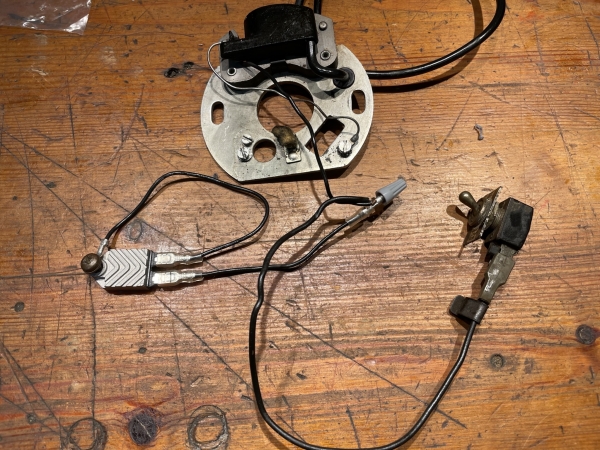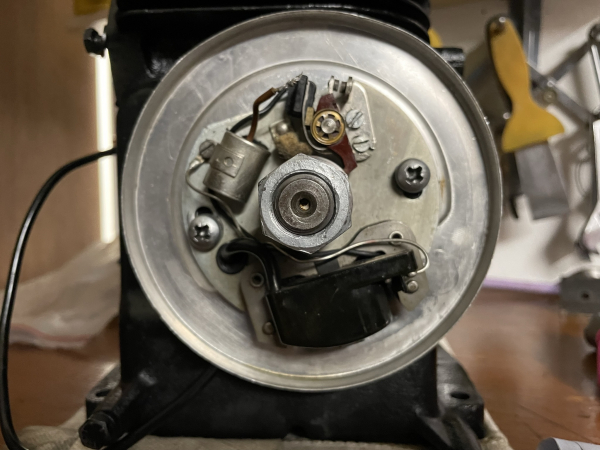Twenty Four electronic Ignition wiring check
Hi, I'm at the point of the rebuild ready to instal the ignition system. Im going to instal electronic Ignition and leave the condenser and points off. So the instal has to be right first time, hence this question. I have attached my thoughts on the wiring assuming its negative earth? I'm going to keep the switch.
I'm not sure about the bare wire from the coil to the face plate?
Can I test it some way before instal?

Thank you.
Forums
Thank you for your response.
Thank you for your response. I have completely forgotten about the position of the stator plate, thank you for the prompt. Did you agree the wiring is correct?
Did you agree the wiring is
Did you agree the wiring is correct?
Looks fine.
Thank you, much appreciated
Thank you, much appreciated
John
To time or not to time…
To time or not to time. F15Villiers
The lobe to operate the points is keyed to the crankshaft, the flywheel is also keyed to the crankshaft. So the setting of the points is simple at TDC firing.
So what are the slots under the large cross head screws used for, see photo?
Is it to position the magneto relative to the magnets laging or leading (not the gap) the flywheel and then reset the points? if so how is this done?

Thank you
Compliments to those involved in the "new" site layout.
Those slots allow the stator…
Those slots allow the stator to be moved to the position at which the contact breaker points start to open in relation to the position of the crank and piston. So, first set the points gap to .46mm (18thou” ) then with the piston set to 3.17mm (.125”) Before Top Dead Centre the stator is moved to the position where the points just start to open. Traditionally a piece of “ fag paper” is grasped between the points and gently tensioned and then the stator moved until it is just released. These days substitute a multimeter.
If I set the points to .018”…
If I set the points to .018” at the peak of the lobe, then rotate engine anti-clockwise to 0.125” BTDC, then rotate the stator plate the points gap doesn’t close anywhere near enough to set a papers width. What am I doing wrong?
What am I doing wrong? Not…
What am I doing wrong?
Not sure!
I've not got an F15 around here to experiment with at present but the only thing that goes through my mind is that the parts book indicates the the crank has a removeable cam ring to operate the points . It's possible that it can be fitted the wrong way round and that the profile is not symmetrical, and is throwing out the points opening in relation to the piston. Wild guess.
In case I have not explained things correctly , pages 28,29,30 of this F15 manual explain it. A dial gauge is useful but not essential - eyeball and touch is sufficient.
https://www.dropbox.com/s/qbzpnukk2kgc8p5/Villiers%20F150001.pdf?dl=0&n…;
Thank you for the info, very…
Thank you for the info, very much appreciated.


To answer your last question
To answer your last question first - not unless you can borrow a specific electronic ignition test box that has the facility to simulate the rotating flywheel. Even back in the day very few workshops had them as the basic testers were usually priced at around £ 4/500 and plus the cost of a specific flywheel simulator adaptor for every type of ignition: it was more cost effective to have a couple of spare known good electronic coils for popular engines.
The bare wire from the coil still goes to earth. As far as I know the Nova module that you have chosen is not polarity sensitive but in the absence of any specific information from the supplier I would be inclined to Earth the negative terminal. I’ve always prefer the Meco units as they take up less space inside the magneto and only have one terminal . That said either unit may be fitted outside the mag.
Hopefully, before removal you marked the position of the stator plate or can see any witness marks left by its securing bolts and their washers. If you don’t have any reference marks , either try it with the bolts in the centre of the slots or pop the points back on and time it as you would pre conversion.